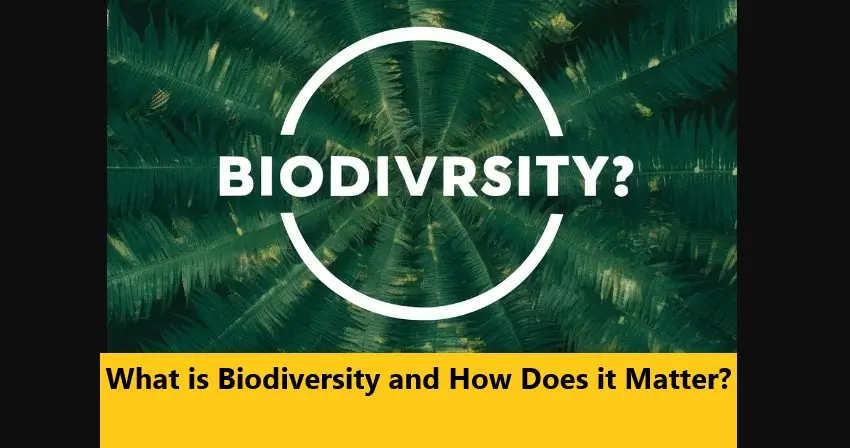What is Biodiversity and How Does it Matter?
What is Biodiversity and How Does it Matter?
A Vibrant Tapestry of Life: Understanding Biodiversity
A diverse array of interconnected living organisms forms the foundation of healthy and resilient ecosystems.
From microscopic bacteria to towering trees, this incredible variety, known as biodiversity, is the very essence of life on Earth. Imagine a vibrant tapestry woven with countless threads, each representing a unique species.
Read More: Top Tourist Places to Visit in Gwadar
This intricate web sustains land, marine, and freshwater ecosystems, providing the very things we rely on – food, clean air, medicine, and natural resources.The Delicate Balance: How Biodiversity Supports Us Biodiversity plays a crucial role in maintaining a healthy planet.
Ecosystems teeming with diverse species are more resilient, able to adapt to changing conditions and recover from disturbances.
These ecosystems provide essential services for all life forms, including: Pollination: A multitude of insects and animals like bees, butterflies, and birds pollinate plants, ensuring the reproduction of many crops that feed us.
Solutions and a Call to Action:
- While the consequences are stark, it’s valuable to end on a hopeful note. Briefly mention some solutions to biodiversity loss, such as habitat restoration, sustainable agriculture practices, and supporting conservation efforts.
- You could also include a call to action, encouraging readers to learn more about biodiversity conservation and how they can contribute.
Examples of Biodiversity Loss:
- Consider including specific examples of species threatened by extinction due to human activity. This could personalize the issue and evoke a stronger emotional response.
Here’s an example of how you could incorporate these suggestions:
The Ripple Effect: Consequences of Biodiversity Loss
The richness of plant and animal life within an ecosystem is not just beautiful, it’s vital. A diverse array of species ensures healthy soil, efficient nutrient cycling, and food security for humans and animals. Furthermore, genetic diversity within species allows them to adapt to changing environments, including diseases and climate extremes.
However, human activities are disrupting this delicate balance at an alarming rate. The natural extinction rate pales in comparison to the current rate, estimated in the tens of thousands of species lost annually due to human impact. This rapid decline is often caused by habitat destruction, pollution from pesticides, and unsustainable hunting practices.
The consequences of biodiversity loss are far-reaching. The World Wide Fund For Nature (WWF) reports a 70% decline in global populations of mammals, birds, fish, reptiles, and amphibians since 1970. This loss is comparable to the mass extinction event caused by an asteroid 66 million years ago!
The destruction of biodiverse rainforests like the Amazon, home to 10% of the world’s known species, threatens the survival of countless creatures. Monoculture farming practices, where vast areas are dedicated to single crops, further strain natural resources and reduce biodiversity.
This decline in biodiversity has a direct impact on us. It affects the quality of our air and water, our ability to fight diseases, and the very food we eat.
But there is hope! We can address this challenge through habitat restoration projects, supporting sustainable agricultural practices, and advocating for policies that protect endangered species. By educating ourselves and taking action, we can ensure a future where humans and nature thrive in harmony.
Let’s work together to safeguard the incredible tapestry of life on Earth. Visit the websites of organizations like the WWF or explore local conservation efforts to learn more and get involved. Remember, every action, big or small, contributes to a healthier planet for all.
key actions needed to protect biodiversity:
1. Reduce Reliance on Harmful Practices:
- Pesticide Ban: Implementing bans or restrictions on harmful pesticides, like those being enacted in the EU, can safeguard vital pollinator populations like bees. This protects not only biodiversity but also ensures healthy crop pollination – crucial for food security.
2. Sustainable Resource Management:
- Protect Lands: Protecting ecologically sensitive areas like rainforests through government initiatives and conservation efforts is essential. This curbs deforestation and habitat destruction, allowing existing ecosystems to thrive.
- Responsible Sourcing: Consumers and businesses can play a role by demanding responsibly sourced products like wood or food items. This reduces pressure on biodiversity hotspots by discouraging unsustainable resource extraction practices.
Here are some additional actions that could be included:
- Habitat Restoration: Actively restoring degraded ecosystems by planting native trees and vegetation can create new habitats for displaced species.
- Supporting Sustainable Agriculture: Promoting and adopting practices like organic farming and crop rotation can minimize pollution and create more diverse agricultural landscapes.
- Raising Awareness: Educating the public about the importance of biodiversity and the consequences of its loss can inspire individual action and support for conservation efforts.
- Investing in Conservation: Supporting research and conservation organizations working to protect endangered species and their habitats is crucial.
By implementing a combination of these actions, we can create a more sustainable future for both humans and the incredible diversity of life on Earth.
Note: The information above might not be accepted 100%. Please verify from your own sources. We will not be responsible for any kind of loss due to our content.
For more news, please visit Munafa Marketing.

